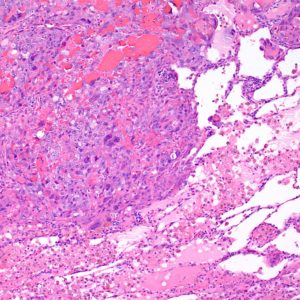Mesothelioma Information - What You Should Know

Mesothelioma is a rare but aggressive form of cancer caused by exposure to asbestos. The disease develops in the mesothelium, a fine lining that surrounds several important organs in the body. Specifically, mesothelioma involves the lining of the lungs, chest cavity, abdomen, heart and/or testicles. Over time, it can spread throughout the body.
Asbestos is the only known cause of mesothelioma. Because asbestos fibers are invisible, people who are diagnosed with the illness are likely to have inhaled or ingested asbestos unknowingly. Symptoms of mesothelioma may not arise until decades after exposure. For that reason, it is not easily detected or may be mistaken for another disease.
If you or someone you love is suffering from mesothelioma, it’s possible to obtain financial compensation to help cover medical costs and expenses related to the disease. Contacting a mesothelioma lawyer who can inform you of your legal options is the best first step.
Asbestos and Mesothelioma
Asbestos is a naturally occurring mineral. Its durability and heat-resistant properties made it a material of choice in a variety of industries, such as construction, shipbuilding, mining, manufacturing, power plants and more.
The carcinogenic dangers of asbestos were widely recognized in the U.S. by the 1970s, and safety precautions were put in place. However, asbestos is still not banned in this country, and it can still be found in products such as insulation, brake pads, roof coatings, floor tiles, shingles and some clothing. It may also still be present in older buildings, schools, churches and other locations where mitigation has not been performed.
When asbestos fibers are damaged or disturbed, tiny particles are released into the air. People who breathe in or swallow the microscopic fibers are at risk to develop mesothelioma, lung cancer, asbestosis and other diseases. However, not everyone who is exposed to asbestos will develop an asbestos disease.
Who Gets Mesothelioma?
Mesothelioma is usually diagnosed in people between the ages of 50 and 70, although younger people are at risk, too. Statistically, more men develop mesothelioma than women. The disease is more likely to develop in individuals who worked in occupations where asbestos was present in greater amounts, or who worked in those jobs for prolonged periods of time.
 However, a bystander passing an active asbestos job site could be just as likely as one of the workers to be exposed to airborne asbestos. There is no safe level of asbestos exposure.
However, a bystander passing an active asbestos job site could be just as likely as one of the workers to be exposed to airborne asbestos. There is no safe level of asbestos exposure.
The Mayo Clinic reports that a person’s unique health history, lifestyle choices, environment and any inherited conditions are possible contributing factors explaining why some people develop mesothelioma and others don’t.
Types of Mesothelioma
There are four types of mesothelioma. Each type is defined by where the malignant tumor originates in the body. They include:
Pleural Mesothelioma (Lungs)
Pleural mesothelioma is the most common form of mesothelioma. It is not lung cancer. Lung cancer develops directly in the lung tissues. By contrast, pleural mesothelioma cells grow in the thin membranes lining the lungs.
Some symptoms of pleural mesothelioma are non-specific. That can make it difficult for doctors to differentiate it from other types of respiratory conditions. Common symptoms of pleural mesothelioma include:
- Coughing
- Shortness of breath
- Unexplained weight loss
- Fatigue
- Pleural effusion (fluid around the lungs)
- Unusual lumps of tissue under the skin of the chest
Doctors can perform a variety of tests to confirm a pleural mesothelioma diagnosis. They may do a biopsy to collect a tissue sample for analysis. If there is pleural effusion, it is possible to extract some of the fluid for testing. A variety of imaging tests, including X-rays, CT scans, PET scans and MRIs can be used to make a diagnosis. Bloodwork is not considered a reliable source for diagnosing mesothelioma. However, high levels of osteopontin and soluble mesothelin-related peptides (SMRPs) in the blood make a diagnosis more likely.
Peritoneal Mesothelioma (Abdomen)

Peritoneal mesothelioma is the second-most common type of mesothelioma. Peritoneal mesothelioma is a cancer that grows in the lining around the abdominal cavity, also known as the peritoneum. About 20 percent of all mesothelioma cases are peritoneal mesothelioma, and oftentimes symptoms don’t emerge until 15 to 60 years after asbestos exposure.
Most people who suffer from peritoneal mesothelioma are middle-aged to older men. Many worked in professions where asbestos exposure was abundant, such as the military, factories, shipyards or industrial sectors.
Although peritoneal mesothelioma is an aggressive disease, the symptoms are often so generalized that a diagnosis may be overlooked until the illness is in advanced stages. Common symptoms of peritoneal mesothelioma are:
- Loss of appetite
- Unexplained weight loss
- Abdominal pain
- Fluid build-up around the abdomen (called ascites)
- Constipation
- Diarrhea
- Pain
- Night sweats
Diagnosing peritoneal mesothelioma may involve imaging tests, such as X-rays, CT scans, MRIs and PET scans. A tissue biopsy is the most effective way to verify the diagnosis. Depending on the location of the tumors, doctors may be able to take a sample in a simple outpatient procedure. Other biopsies may be more invasive and require hospitalization.
Pericardial Mesothelioma (Heart)
Pericardial mesothelioma is cancer of the membrane surrounding the heart. It is extremely rare, occurring in only 1 to 2 percent of all mesothelioma cases. Like all forms of mesothelioma, it can take as long as 60 years before symptoms emerge. The subtle nature of pericardial mesothelioma symptoms may mimic more common heart conditions, leading to a delayed diagnosis and poorer prognosis.
Possible signs of pericardial mesothelioma include:
- Chest pain
- Heart palpitations
- Inconsistent pulse rate (called paradoxical pulse)
- Pericardial effusion (fluid build-up around the heart)
- Difficulty breathing
- Weight loss
- Acute or chronic cough
- Overall weakness
Verifying a pericardial mesothelioma diagnosis could require an echocardiogram, a test that uses sound waves to identify if there is fluid around the heart and whether the heart is working well. Additional imaging tests such as X-rays, CT scans or MRIs can identify the location of the cancer. Doctors also use two other diagnostic procedures to confirm a pericardial mesothelioma diagnosis:
- Pericardioscopy: A doctor inserts a tube with a camera on it to examine the tissue around the heart. It is possible to take tissue samples for biopsy during the procedure.
- Pericardiocentesis: A needle is inserted into the sac around the heart to remove fluid to test for cancer cells.
Testicular Mesothelioma
Testicular mesothelioma is also called mesothelioma of the tunica vaginalis testis. It is the rarest form of mesothelioma. In fact, it is so rare that research about testicular mesothelioma is very limited. That also means it is difficult to determine the progression of the disease or make predictions about life expectancy.
Like the other forms of mesothelioma, the symptoms of testicular mesothelioma may be mistaken for more common problems for men, such as an inguinal hernia or another form of testicular cancer. Signs of testicular mesothelioma may include:
- Lump or mass on the testicle
- Hydrocele (fluid build-up in the scrotum, causing swelling)
- Pain in the testes
 The most definitive way to diagnose testicular mesothelioma is to perform a tissue biopsy. Doctors may also use an ultrasound to look for swelling or masses in the scrotum. Blood tests cannot confirm a diagnosis of testicular mesothelioma, but the elevated presence of certain substances in the blood (e.g., calretinin, cytokeratin 5/6, Wilms’ tumor gene 1) can be linked to mesothelioma.
The most definitive way to diagnose testicular mesothelioma is to perform a tissue biopsy. Doctors may also use an ultrasound to look for swelling or masses in the scrotum. Blood tests cannot confirm a diagnosis of testicular mesothelioma, but the elevated presence of certain substances in the blood (e.g., calretinin, cytokeratin 5/6, Wilms’ tumor gene 1) can be linked to mesothelioma.
Stages of Malignant Mesothelioma
Doctors use staging systems to determine how far a patient’s mesothelioma has progressed. Staging is also important to identify what treatment options are appropriate for the patient.
There are five stages of malignant mesothelioma, with some sub-types possible depending on which staging system a physician chooses to use.
The stages of mesothelioma are:
- Stage One: The tumor is localized on one side of the body and has not spread to other regions.
- Stage Two: The cancer cells have spread to other close organs.
- Stage Three: Mesothelioma is now present in nearby body parts and possibly the lymph nodes.
- Stage Four: The cancer has metastasized throughout the body, including the lymph nodes.
At this time, the American Joint Committee on Cancer only recognizes one formal staging system for pleural mesothelioma. The Tumor, Nodes and Metastasis (TNM) system is the most commonly used. TNM stands for:
- T: The tumor’s size and extent throughout the body.
- N: Whether the tumor has progressed into the lymph nodes.
- M: If the cancer has metastasized to other organs.
There is no accepted system for staging peritoneal mesothelioma, although doctors may also use the TNM system as a guide to determine what stage they think the disease is. There is also no specific staging system for pericardial or testicular mesothelioma because the cases are so rare.
Treatment Options for Mesothelioma
Currently, there is no cure for mesothelioma. A number of treatment options are available to lessen the person’s discomfort and increase his or her life expectancy. Doctors identify the appropriate treatments based on the stage of the disease and individual factors such as the patient’s overall health, age and quality of life.
Surgery
 Surgery is often recommended for people in the early stages of mesothelioma. The procedures may be used alone or in conjunction with chemotherapy or radiation therapy. Examples of surgeries by mesothelioma type include:
Surgery is often recommended for people in the early stages of mesothelioma. The procedures may be used alone or in conjunction with chemotherapy or radiation therapy. Examples of surgeries by mesothelioma type include:
Pleural mesothelioma
- Pleurectomy: Removal of the pleura (inner and outer lining) of the lungs. Some lung tissues or the coating around the diaphragm may be removed in this procedure as well.
- Extrapleural pneumonectomy: The lung, any involved tissue and nearby lymph nodes may be removed.
Peritoneal mesothelioma
- Cytoreduction/debulking: This involves the removal of all visible tumors from the abdomen and affected organs, such as the intestines. Heated interoperative chemotherapy, or HIPEC, may be added to kill any remaining cancer cells.
- Omentectomy: The omentum is fatty tissue that covers the abdominal organs. If the disease has spread there, a doctor may remove the affected areas.
Pericardial mesothelioma
- Pericardiectomy: All or part of the tissue lining the heart is removed.
- Resection: The tumor is removed without removing the pericardium.
Testicular mesothelioma
- Radical inguinal orchiectomy: The testicle and spermatic cord are removed.
Chemotherapy
Chemotherapy uses a combination of drugs to kill or shrink cancer cells. It may be used before surgery, during an operation or post-operatively to attack any remaining cancer cells. Chemotherapy is also used for mesothelioma patients who are not candidates for surgery.
Radiation Therapy
In radiation therapy, a doctor uses radiation to target and kill cancer cells. It may be used as a primary treatment option for mesothelioma or in combination with surgery and chemotherapy. However, it can be a difficult procedure because mesothelioma tumors usually don’t develop as single, distinct masses. Even with targeted radiation, it is possible that healthy tissues could be affected as well.
Palliative Care
 Patients with advanced stages of mesothelioma may be treated best with palliative care that focuses on relieving discomfort. Possible palliative treatments might be:
Patients with advanced stages of mesothelioma may be treated best with palliative care that focuses on relieving discomfort. Possible palliative treatments might be:
- Fluid removal: Depending on the location of the mesothelioma, it may be possible to remove fluid build-up through a pleurocentesis (lungs), paracentesis (abdomen) or pericardiocentesis (heart).
- Shunt: This device can be implanted as a means to remove fluid from one part of the body to another.
- Catheter: This tube removes unwanted fluid and drains it into a bag or bottle outside of the body.
Life Expectancy for People Living with Mesothelioma
Life expectancy means how many years a person is expected to live. A serious disease like mesothelioma can reduce a patient’s life expectancy dramatically.
Life expectancy after a mesothelioma diagnosis depends on several factors, including:
- The stage of the mesothelioma
- The type of cancer
- The kind of cells in the tumor
- The treatments that are done
- The age of the patient
- Blood biomarkers (e.g., platelets, white blood cell count)
Taking those factors into account, mesothelioma patients generally live anywhere from six months to 22 months following diagnosis. However, much depends on the individual so the prognosis varies from patient to patient.
Compensation for Mesothelioma Patients
 A mesothelioma diagnosis can create significant financial hardships for patients and their families. Cancer treatment is expensive and often long-term. Mesothelioma patients may need to purchase specialized medical equipment or hire caregivers to help with daily life tasks. Covering such expenses can be a challenge.
A mesothelioma diagnosis can create significant financial hardships for patients and their families. Cancer treatment is expensive and often long-term. Mesothelioma patients may need to purchase specialized medical equipment or hire caregivers to help with daily life tasks. Covering such expenses can be a challenge.
But financial help is available for people living with mesothelioma and families who have lost a loved one to the asbestos cancer. Many companies were aware that asbestos was a health hazard but did not take steps to warn workers and the public. An experienced mesothelioma lawyer can help patients and families demand compensation from these companies for a number of losses, such as:
- Past, current and future medical expenses
- Lost wages and lost future earnings
- Travel expenses for medical treatment
- Inability to support dependents
- Pain and suffering
- Funeral and burial expenses
There are several routes that can be taken to recover mesothelioma compensation. The main option is to file a legal claim against the company or companies responsible for the patient’s asbestos exposure. Money is awarded through legal settlements or a jury verdict.
Compensation may also be possible through asbestos bankruptcy trust funds, which are set up by asbestos companies that have gone through the bankruptcy process and put aside money to pay future mesothelioma victims. Money may also be available for veterans who were exposed to asbestos during their military careers. Workers’ compensation benefits and Social Security disability benefits are other avenues for compensation for mesothelioma victims.
Talking with an experienced asbestos attorney is the best way to determine your eligibility for mesothelioma compensation. A skilled lawyer can investigate your claim, talk to witnesses, obtain your medical records and examine your work history/service history to determine who should be held accountable for your mesothelioma. That information will be the foundation of a strong legal claim so that you receive the compensation that you deserve.
If you suffer from mesothelioma and think you are entitled to compensation, please reach out to us for a free consultation. A knowledgeable lawyer will discuss your case and explain your legal rights with no strings attached. You should also know that mesothelioma lawyers do not charge any fees unless they recover compensation on your behalf.
Being diagnosed with mesothelioma can be overwhelming, but with legal help, you may be able to secure a solid financial future for you and the ones you love.
